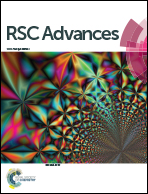Enhancing the Vickers hardness, melting point and thermodynamic properties of hafnium dodecaboride†
Abstract
Although HfB12 is a promising surperhard material because of the boron cuboctahedron cage, the Vickers hardness of HfB12 remains controversial. We apply first-principles calculations to investigate the influence of a transition metal on the structural stability, Vickers hardness and thermodynamic properties of HfB12. The Vickers hardness of HfB12 is 39.3 GPa. In particular, the Vickers hardness of TM-doped HfB12, which are novel superhard materials, is larger than 40 GPa. The Vickers hardness of Re-doped HfB12 is up to 47.6 GPa. The improvement of Vickers hardness is that the introduction of an alloying element improves the localized hybridization between B and Hf, and then enhances the bond strength of the B–B covalent bond and the Hf–B bond. In addition, these alloying elements enhance the melting-point and Debye temperature of the HfB12. Therefore, we believe that alloying is an effective method to improve the Vickers hardness and thermodynamic properties of HfB12 superhard material.



 Please wait while we load your content...
Please wait while we load your content...